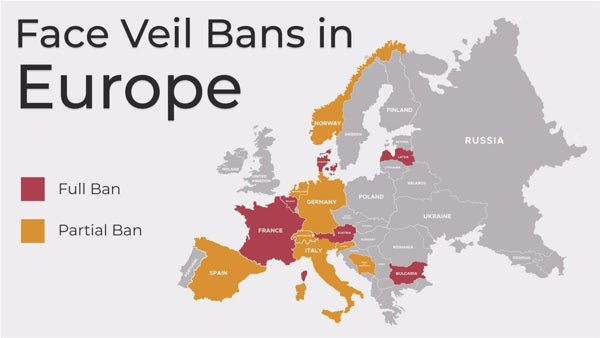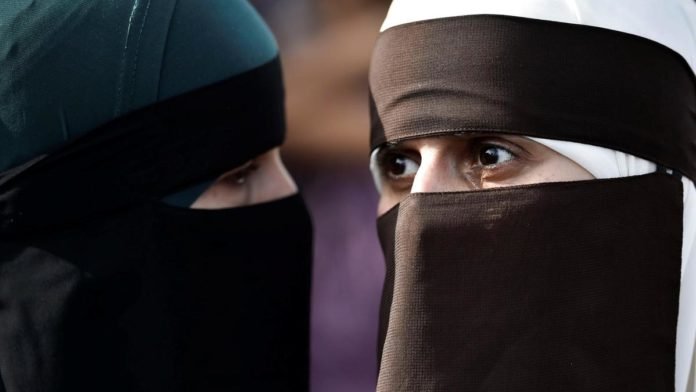Any garment that entirely hides the face including burqas and ski masks are from Thursday banned from Dutch public spaces but doubts remain over how the legislation will be enforced.
The rule, ratified last summer by the Senate, defines the ban as “partial” and not “total,” because it only limits the use of these garments in public areas such as schools, hospitals, public transportation and government buildings.
Although it was expected to take effect earlier this July, schools requested it be postponed so that its application did not complicate the end of the school year and cause tensions with mothers who use Islamic garments such as the burqa — which covers the entire face — or the niqab, which leaves the area around the eyes clear.
Can it be enforced?
However, there are still doubts over how it will be enforced in practice with those found in breach to be fined €150 as some people will continue to be allowed to cover their faces in public for health and safety reasons.
Furthermore, transport companies have already signalled they will not enforce the ban in order to prevent delays. Bus and train drivers are required to deny entry to any person whose face is hidden and are obliged to stay still until police arrive.
The police, meanwhile, after consultation with the government, said that they will not go “after a moving tram in which a person is breaking the law by covering their face.”
The Dutch Federation of University Medical Centres also rejected the implementation of the law over fears that women with burqas will avoid medical care if they are not allowed to enter the centres and warned that hospitals “should not take care of this task, which is the responsibility of the Police and the judiciary. ”
A spokesman for the Dutch Ministry of Interior explained that they will continue talking with the competent authorities to discuss the implementation of the law and stressed that there are always doubts about how to force compliance of new rules.
Freedom of religion
The ban was put on the agenda thirteen years ago by the ultra-right-wing politician Geert Wilders, who demanded a total ban on the burka because, according to him, it prevents the integration of women into the social and working life of the country.
In response to this ban, the Islamist party of Rotterdam, NIDA, offered to pay fines to women who choose to continue using this garment in public spaces, and warned that “freedom of religion is at stake” and that it would lead to the stigmatisation and isolation “of women who wear the integral veil.”
The Netherlands follows in the footsteps of Denmark, France and Belgium where the ban also extends to the streets, after the European Court of Human Rights ruled in 2014 that such a law does not violate religious freedoms.
On the other hand, in Italy (in Novara, near Milan) and Spain (in Catalonia) some limitations have been imposed on the burqa, although not at the state level.
Other EU and european countries that ban face veils

In Europe, veil bans are generally aimed at items of clothing which cover large portions of the face, including masks and certain helmets. They predominantly tend to target religious garments, such as the niqab or burqa. Such legislation has been criticized as singling out dress worn by conservative Muslim women, and comes amid concerns about growing Islamophobia in Europe.
What follows is a list of European countries which have introduced veil bans.
France goes first
France was the first European country to put a ban on wearing a burqa or niqab in public. The legislation has been in force since April 2011. In order to quell allegations of discrimination, the wording of the law deliberately avoids mentioning religious veils, stating instead in general terms: “In the public sphere, no-one must wear an item of clothing that serves to cover the face.” In addition, wearing any kind of religious clothing (including head scarves) in schools has been banned since 2004.
It is estimated that France’s ban on burqas and niqabs affects only some 2,000 Muslim women, because that is the number of people — among a total of 5 million Muslims in France — believed to wear either a niqab or a burqa.
Belgium
In July 2011, Belgium also enacted a ban on covering one’s face in public areas. Offenders can incur fines or jail sentences of up to seven days. As in France, the ban affects a relatively small number of people. It is estimated that, among the 1 million Muslims in all of Belgium, some 300 women either wear a burqa or niqab.
Limited ban in the Netherlands
The Dutch parliament introduced legislation targeting the veil in 2016. Since then, wearing full-body veils and face veils is not generally banned, but it is prohibited in public buildings, public transport, schools and hospitals. Offenders can incur fines of up to €400 ($466). As in France and Belgium, the number of women who wear either a burqa or a niqab is rather small (roughly 100 according to government estimates).
Exceptions in Bulgaria
Bulgaria also introduced a veil ban in 2016. Offenses are punishable by fines of up to €750 ($875). There is no general ban: Exceptions are in place in the areas of sport activity, the workplace and religious service.
Austria
In October 2017, Austria officially outlawed face veils with its “anti-face veil law.” The legislation stipulates that all facial features between the chin and hairline must be visible in public. If they aren’t, the offender in question may have to pay a fine of up to €150 ($175).
Most recently: Denmark
On May 31, the Danish parliament passed a ban on wearing full-face veils in public, following a 75-30 vote. The law will come into force in August. Offenders can incur fines of up to €134 ($157). Repeat offenses are punishable by up to 10 times that amount.
Debates in other countries
Many European countries have seen discussions of a veil ban, including Germany, Switzerland, Estonia, Latvia, Lithuania and Norway. Local veil bans had been introduced in parts of the Spanish region of Catalonia, but they have been repealed by courts. In Italy, full-face veil bans are not the subject of debate because the country already introduced a general ban in the 1970s on items of clothing which make it difficult to identify a person.
This is a "Pay as You Feel" website Please help keep us Ad Free.
You can have access to all of our online work for free. However if you want to support what we do, you could make a small donation to help us keep writing. The choice is entirely yours.


























You must be logged in to post a comment.